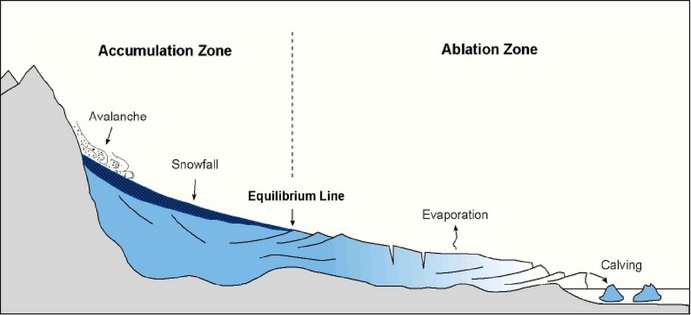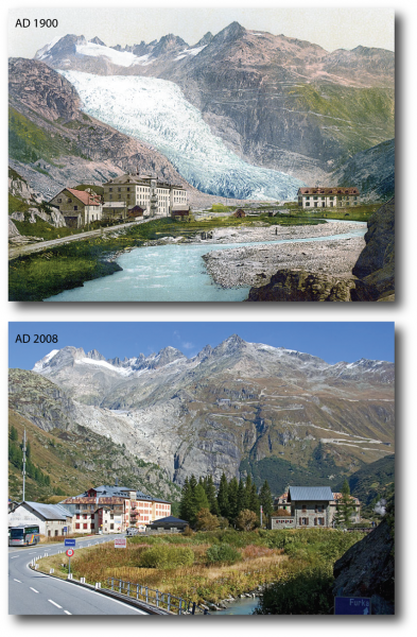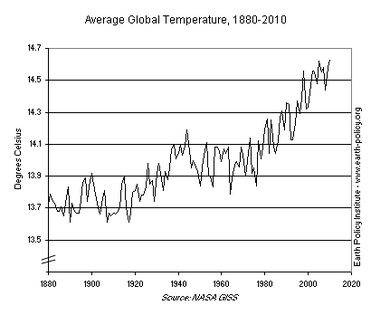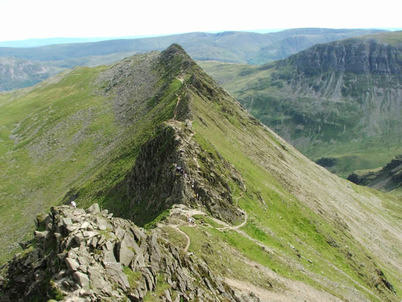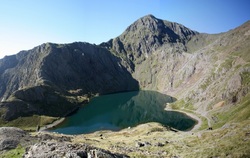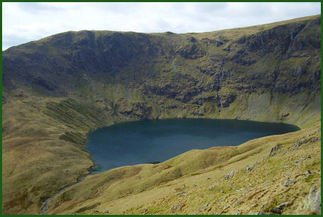GCSE Geography First Hand
Ice On the Land
Ice Levels over Time
- The Earth has Glacial Periods and Interglacial Periods.
- The Earth goes through cold periods which last for millions of years called Ice Ages. During Ice Ages, large masses of ice cover parts of the Earth's Surface.
- The last Ice age was the Pleistocene that began 2.6million years ago.
- During ice ages there are cooler periods called Glacial Periods when the ice advances to cover more of the Earth's surface. Each Glacial Period last for roughly 10,000 years.
- Inbetween the Glacial Periods are warmer periods called Interglacial Periods when the ice retreats to cover less of the Earth's surface. Again, each one lasts around 10,000 years.
- Since the beginning of the Pleistocene there have been permanent ice sheets on Greenland and Antarctica. Ice has also covered other parts of the world during the colder glacial periods.
- Ice covered a lot more of the Earth's surface around 20,000 years ago (during the last glacial period)-over 30% of the Earth's surface was covered by ice, including nearly all of the UK.
- We're currently in an Interglacial Period that began 10,00 reas ago. Today 10% of the Earth's surface is covered by ice-the only ice sheets are the ones in Greenlan and Antarctica.
Evidence of Changing Temperature
There are three:
1. Chemical Evidence-The chemical compostition of ice and marine sediments change as temperature changes, so they can be used to work out how global temperature has changed in the past. Ice and sediments build up over thousands of years so samples taken from different depths show the temperature over thousands of years. The records show a pattern of increasing and decreasing temperature, which caused the ice to advance and retreat.
2. Geological Evidence-Some Landforms we can see today were created by glaciers in the past. This
this shows that some areas that aren't covered in ice today were covered in the past, which means the temperature was lower.
3. Fossil Evidence-The remains of organisms are preserved when they die, creating fossils. Fossils
show the distribution of plants and animals that are adapted to warm or cold climates at different times in the past. From this we can tell which areas were warmer or colder in the past.
1. Chemical Evidence-The chemical compostition of ice and marine sediments change as temperature changes, so they can be used to work out how global temperature has changed in the past. Ice and sediments build up over thousands of years so samples taken from different depths show the temperature over thousands of years. The records show a pattern of increasing and decreasing temperature, which caused the ice to advance and retreat.
2. Geological Evidence-Some Landforms we can see today were created by glaciers in the past. This
this shows that some areas that aren't covered in ice today were covered in the past, which means the temperature was lower.
3. Fossil Evidence-The remains of organisms are preserved when they die, creating fossils. Fossils
show the distribution of plants and animals that are adapted to warm or cold climates at different times in the past. From this we can tell which areas were warmer or colder in the past.
Glaciers
A Glacier is a moving body of Ice
Glaciers form where the accumulation of snow and ice exceeds ablation. As the snow and ice thicken, they reach a point where they begin to move, due to a combination of the surface slope and the pressure of the overlying snow and ice.
Glaciers form where the accumulation of snow and ice exceeds ablation. As the snow and ice thicken, they reach a point where they begin to move, due to a combination of the surface slope and the pressure of the overlying snow and ice.
The Glacial System
- A Glacier has a Zone of Accumulation and a Zone of Ablation:
- The input of the Glacier-Snow and Ice.
- There is more Accumulation than Ablation at the top of the Glacier.
- The output of a Glacier is water as the ice melts.
- There is more Ablation the Accumulation at the snout of the Glacier.
The difference between Accumulation and Ablation is the Glacial Budget
- This difference is the total from one year
- The amount of ice in a Glacier, and whether it's advancing or retreating, depends on thr Glacial Budget:
- A positive Glacial Budget is when the inputs(Accumulation) exceed the outputs(Ablation). The Glacier gets larger and the snout (the end of the Glacier) advances down the Valley.
- A negative Glacial Budget is when the outputs(Ablation) exceed the inputs(Accumulation). The Glacier gets smaller and the snout reatreats up the valley.
- If there's the same amount of Accumulation and Ablation over a year, the Glacier stays the smae size and the position of the snout doesn't change.
The Glacial Budget Changes in the Short-Term and the Long-Term
Temperature changes throughout the year amd over the years. Both thes things affect the Glacial Budget:
1. Glaciers advance and retreat seasonally:
Temperature changes throughout the year amd over the years. Both thes things affect the Glacial Budget:
1. Glaciers advance and retreat seasonally:
- In the summer there's more Ablation than Accumulation because more ice melts when its warm. this means there's a negative Glacial Budget so Glaciers retreat
- In the winter there's more Accumulation than Ablation because there's more snowfall and less melting. This means there's a positive Glacial Budget so Glaciers advance.
Case Study 16-Glaciers
Rhone Glacier, Switzerland, The Alps:
- In the Swiss Alps
- 7.8km long
- Has been retreating since the 19th Century.
- Pictures show the different size and position of the Glacier over the years, e.g. These photos from 1900 and 2008 show the contrast
2. Monitoring Data the length of the Rhone Glacier has been measured since 1879. This graph shows the decrease in length in green(ignore the red line):
3. The amount of Meltwater-as the Glacier retreats it produces more Meltwater. The Meltwater has formed a new lake in front of the Glacier which has been increasing in size. The shows the glacier has been melting more rapidly.
Global Warming is the Cause:
Global Warming is the Cause:
- There's a consensus among scientists that Glacial Retreat is caused by Global Warming. The graph shows an increase in average Global Temperature of about 0.9 degrees in the last 150 years.
2. In recent decades, parts of Switzerland have had above average temperature rises-a weather station near the Rhone Glacier recorded an increase of 1.8 degrees between 1937 and 2005. This is though to be because Switzerland has no coastline(the sea has a cooling affect on the land)
Glacial Erosion
Glaciers Erode the Landscape as they move:
1. The weight of the ice in a Glacier makes it move downhill, eroding the landscape as it goes
2. The moving Ice erodes the landscape in two ways:
4. The rock above Glaciers is also weatherd by the conditions around the Glaciers. Freeze-Thaw weathering happens and bits of rack fall off forming Scree.
1. The weight of the ice in a Glacier makes it move downhill, eroding the landscape as it goes
2. The moving Ice erodes the landscape in two ways:
- Plucking occurs when meltwater at the base, back or sides of a glacier freezes onto the rock. As the Glacier moves forward it pulls pieces of rock out.
- Abrasion occurs where bits of jagged rock stuck in the Ice grind out the rock beneath the Glacier, wearing it away(like sandpaper). The rock where Glaciers used to be have Striations(lines caused by Abrasion), some have been found in Grand Central Park, New York.
4. The rock above Glaciers is also weatherd by the conditions around the Glaciers. Freeze-Thaw weathering happens and bits of rack fall off forming Scree.
Glacial Erosion Landforms
There are seven landforms created by Glacial Erosion:
- Arete-a steep sided ridge formed when two Glaciers flow in parallel valleys. The Glaciers erode the sides of the valleys, which sharpens the ridge between them.
- Corries-Snow collects in a hollow, does not melt and forms firn/neve. More snow accumulates to form Glacial ice. Gravity causes downhill movement. As the ice moves, meltwater freezes to the back wall and sticks. Rocks are plucked off, forming a steep back wall. Freeze-Thaw weathering also breaks off rock. These rocks collect at the bottom of the hollow. Rotational Slip causes maximum erosion by Abrasion, forming a deep Corrie with a steep back wall and a rock lip. When the ice melts, the water collects in the hollow forming a small lake called a Tarn.

